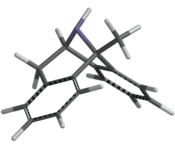Dizocilpine
 |
|
 |
|
| Clinical data | |
|---|---|
| Routes of administration |
By mouth, IM |
| Identifiers | |
|
|
| CAS Number | |
| PubChem CID | |
| IUPHAR/BPS | |
| DrugBank | |
| ChemSpider | |
| UNII | |
| ChEMBL | |
| Chemical and physical data | |
| Formula | C16H15N |
| Molar mass | 221.297 g/mol |
| 3D model (Jmol) | |
| Melting point | 68.75 °C (155.75 °F) |
|
|
|
|
|
|
|
Dizocilpine (INN), also known as MK-801, is an uncompetitive antagonist of the N-Methyl-D-aspartate (NMDA) receptor, a glutamate receptor, discovered by a team at Merck in 1982. Glutamate is the brain's primary excitatory neurotransmitter. The channel is normally blocked with a magnesium ion and requires depolarization of the neuron to remove the magnesium and allow the glutamate to open the channel, causing an influx of calcium, which then leads to subsequent depolarization. Dizocilpine binds inside the ion channel of the receptor at several of PCP's binding sites thus preventing the flow of ions, including calcium (Ca2+), through the channel. Dizocilpine blocks NMDA receptors in a use- and voltage-dependent manner, since the channel must open for the drug to bind inside it. The drug acts as a potent anti-convulsant and likely has dissociative anesthetic properties, but it is not used clinically for this purpose due to the discovery of brain lesions, called Olney's lesions (see below), in test rats. Dizocilpine is also associated with a number of negative side effects, including cognitive disruption and psychotic-spectrum reactions. It also inhibited the induction of long term potentiation. Instead, the NMDA receptor pore-blocker ketamine is used as a dissociative anesthetic in human medical procedures. While ketamine may also trigger temporary psychosis in certain individuals, its short half-life and lower potency make it a much safer clinical option. However, dizocilpine is the most frequently used non-competitive NMDA receptor antagonist in animal models to mimic psychosis for experimental purposes.
Dizocilpine has also been found to act as a nicotinic acetylcholine receptor antagonist. It has been shown to bind to and inhibit the serotonin and dopamine transporters as well.
...
Wikipedia
